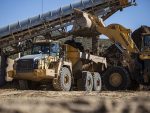Paladin Energy has identified several solutions to help overcome short-term operational challenges as it continues ramping up the Langer Heinrich uranium mine (LHM) in Namibia.
The LHM re-commenced commercial production on 30 March 2024 following the successful completion of the restart project and is undergoing an operational ramp-up during FY2025, with ore feed to the plant sourced from previously mined stockpiled ore.
Mining activities are expected to resume in FY2026, ahead of achieving nameplate production of six million pounds per annum by the end of 2026.
Ore feed impacted
Paladin revealed in its latest quarterly report that it had encountered issues during the period that affected ore feed, recovery rates and production volumes.
The efficiency challenges included variability in the stockpiled ore processed, resulting in a lower feed grade than planned for the quarter.
The mine’s performance was also impacted by the delayed commissioning of a second classification circuit, while lower-than-anticipated tailings water recovery necessitated adjustments to the water balance within the plant, resulting in lower levels of fines rejects and variability in recoveries.
With the Paladin team working through these issues, production continued to ramp up, with 0.64Mlb of uranium produced during the quarter.
Progressing solutions
Chief executive officer Ian Purdy said the operations team is progressing solutions to address the challenges, with an independent third party also engaged to assist in improving the tailings water recovery process.
He noted that significant improvements have been supported by crusher upgrades that have eliminated the previous bottleneck, demonstrating sufficient capacity to achieve full production at the mine.
Paladin is preparing for a planned two-week shutdown in November to allow for further improvements and operational upgrades to be implemented.
Upgrade benefits
“The ramp-up of production at the LHM continues to de-risk the project and demonstrates the benefits of the plant upgrades,” Purdy said
“While production in the second quarter of the ramp-up encountered some process recovery and efficiency challenges, the onsite team has begun implementing operational and process design improvements, which delivered improved performance towards the end of the quarter.”
“Our global clean-energy customers have commenced receiving and processing our product, with Paladin now delivering on its mission to resource a carbon-free future.”
Paladin continues to develop its world-class offtake contract book, with three additional sales agreements signed during the quarter and approximately 23Mlb of production contracted through to 2030.
Guidance
Paladin will continue to use previously mined stockpile ore for production at the Langer Heinrich mine next year, and will restart mining activities in 2026.
Having recently completed the restart of the Namibian mine, Paladin has previously announced its 2025 production guidance of 4-million to 4.5-million uranium oxide (U3O8) at a production cost of US$28/lb to US$31/lb.
Langer Heinrich will be in operational ramp-up in the 2025 financial year, with production levels expected to be higher in the second half of the year.
Mining activities will restart in the 2026 financial year, ahead of achieving nameplate production of six-million pounds a year by the end of the 2026 calendar year. The resurrected mine will have a 17-year mine life, producing 77-million pounds of U3O8.
New Horizons
Last month, it was reported that the effort by Paladin Energy to acquire Canadian-listed uranium explorer Fission Uranium seems to have hit another speed bump, as the Canadian government has stepped in with a national security review of the deal. Per section 25.3 of the Investment Canada Act, the deal now requires further government approval.
The Canadian government is known to be increasingly sensitive about the acquisition of strategic resource companies by overseas shareholders. Paladin Energy is listed in Australia, however, and counts several UK, Canadian and US fund managers among its biggest stockholders.
However, Paladin is working with the China National Nuclear Corp (CNNC), a state-owned entity, on the development of the Langer Heinrich uranium mine in Namibia. China Uranium Corp, a subsidiary of CNNC, acquired 25% of the mine in a 2014 deal. This is what could have raised Canadian government security concerns in the first place.
CNNC is one of the two big players in China’s nuclear sector and partly responsible for securing overseas uranium supplies for China’s nuclear reactors. It has been very active in Africa over the past decade. Ironically for Fission Uranium, China’s other uranium heavyweight, represented by CGN Mining, is a minority shareholder of Fission (11.26%) and has itself acted to block the Paladin deal in the Canadian courts.
China General Nuclear Power Group (CGN) is a state-owned enterprise that operates a number of nuclear plants in China, among them Daya Bay and Ling Ao. It has another five nuclear power plants coming online at the moment. The company has been previously sanctioned by the US government for seeking to steal US nuclear secrets. CGN Mining is its mining arm, and has been focused on sourcing further uranium supplies from abroad, including countries like Kazakhstan and Canada.










